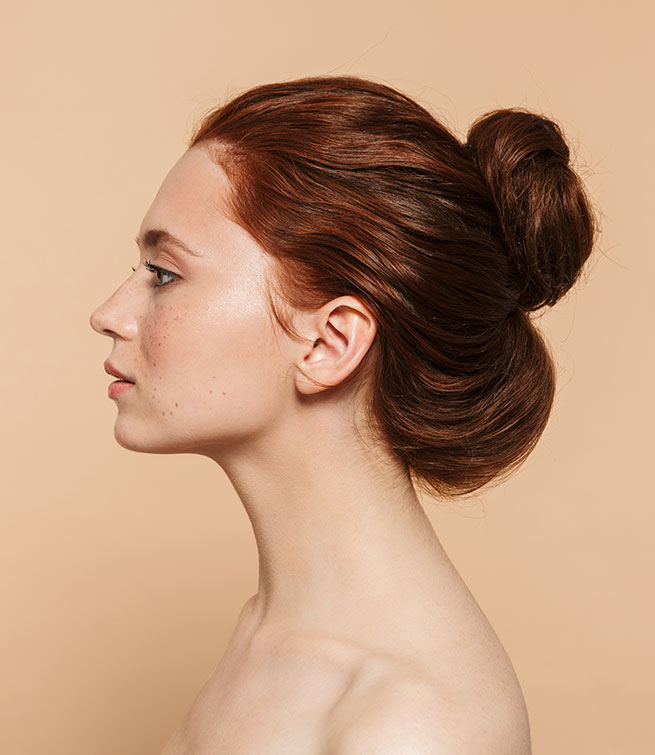As plain as the nose on your face
Straight, flat, hooked, drooping, snub, aquiline, curved or turned-up, each nose has its own personality. However, not everyone is comfortable with their nose. Feeling that it is too prominent or too understated, some would like to change its appearance.
Rhinoplasty
Rhinoplasty is a surgical procedure that modifies the appearance of the nose. It’s a very ancient practice. In antiquity, some procedures were already being done to try to change the shape of the nose. However, these surgical attempts were not always successful. Fortunately, science has made great strides, and today, this procedure is regularly practised by cosmetic surgeons, is very safe, and, in the vast majority of cases, meets patients’ expectations.
A number of reasons may lead you to consider rhinoplasty, whether your nose developed abnormalities due to trauma, cancer, or a congenital illness, or simply for the sake of aesthetics. It can also be a way to resolve nasal dysfunction, such as difficulty breathing. The nose is highly visible, and it’s often one of the first things we see when we look at someone. It can be a source of insecurity for many. A number of factors must be taken into consideration before choosing rhinoplasty.
Preoperative meetings
One or two meetings with the surgeon are necessary before the operation. They will assess your general health. They will also talk with you about what you want to change about your nose. They will then perform an intranasal exam in order to offer the best solutions for you and your situation.
At that stage, it is important to mention any problems with breathing, nasal obstruction or rhinitis that you may have.
The surgeon will advise you based on your particular case in order to get an optimal result in the best possible conditions.
Types of surgery
There are two types of rhinoplasty: open and closed. Closed rhinoplasty is less invasive and does not leave a scar.
Open rhinoplasty is more extensive and leaves a slight scar, generally located on the underside of the nose. This type of operation may also require taking cartilage from the patient to do a graft and complete the reconstruction of the nose.
This second type of surgery may be necessary if many changes must be made to the patient’s nose or in the case of a second operation or a corrective surgery.
Whether open or closed, rhinoplasty is generally carried out under general anaesthesia, but it takes only a few hours. Therefore, you can quickly return to the comfort of your home to start your recovery.
After the operation
The surgeon will conduct several postoperative follow-ups to ensure that the tissues are healing properly and to prevent complications. They will apply an intranasal bandage for 24 to 48 hours to reduce the risk of bruising. Next, a splint, held in place by a new bandage, will be applied to your nose for around two weeks.
Good to know
Here are some things that are good for you to know if you are considering rhinoplasty.
The operation is not painful. However, postoperative swelling may be uncomfortable. After the operation, it is recommended to avoid blowing your nose so that your nose can heal properly.
Those who need glasses to improve their vision should wear contact lenses.
When you come out of the operation, you and your loved ones may be surprised to see bruising under your eyes. They are quite a sight, but don’t worry — they will disappear around one week after the procedure.
Keep in mind that although it is performed regularly, rhinoplasty is still a surgical intervention and may lead to some complications. Infection, although very rare, is among the possible complications your surgeon will tell you about before the operation so you can make an informed decision.
What about cost?
Each operation has its own cost. The final cost will vary depending on how complicated the procedure is.
Know, however, that certain reconstructive surgeries following trauma or cancer may be covered by RAMQ. Ask your surgeon: they will be able to confirm whether or not you are eligible for a reimbursement.
Positive impacts
Once your operation is completed, your nose will blend in better with the rest of your facial features. Whether it was functional, reconstructive or aesthetic, the operation will help you gain or recover your self-confidence. The purpose of the operation is not necessarily to make your nose smaller, but to create a balanced nose, both in size and shape, that fits with the rest of your face.
Contact me to receive expert advice on a potential operation. I am in the best position to help you make the best decision for your specific case.
Click here to learn more about rhinoplasty.
Back to blog
